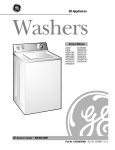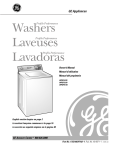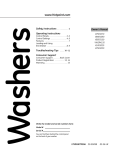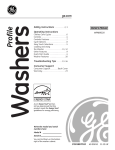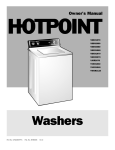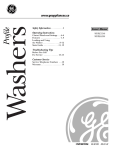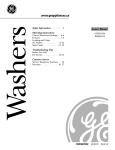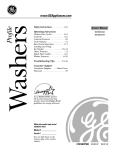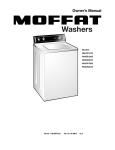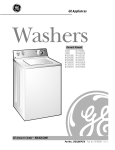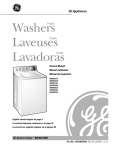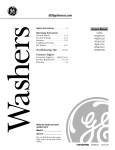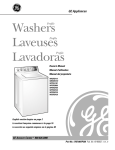Download GE WNSR3100 User's Manual
Transcript
GE Appliances Profile Washers Owner’s Manual WNSR3100 WNSR4100 GE Answer Center ® 800.626.2000 Part No. 175D1807P278 Pub. No. 49-90011 7–99 JR Safety Instructions Safety Information . . . . . . . .3 Welcome to the GE family. We’re proud of our quality products and we are committed to providing dependable service. You’ll see it in this easy-to-use Owner’s Manual and you’ll hear it in the friendly voices of our customer service department. Best of all, you’ll experience these values each time you use your washer. That’s important, because your new washer will be part of your family for many years. And we hope you will be part of ours for a long time to come. We thank you for buying GE. We appreciate your purchase, and hope you will continue to rely on us whenever you need quality appliances for your home. Operating Instructions Operating Instructions Congratulations! You Are Now Part of the GE Family. Control Panels . . . . . . . . . . . . . . . . .4 Control Settings . . . . . . . . . . . . . . . .5 Features . . . . . . . . . . . . . . . . . . . .6, 7 Loading and Using the Washer . .8, 9 A Service Partnership. IMPORTANT! Staple sales slip or cancelled check here. Proof of the original purchase date is needed to obtain service under the warranty. FOR YOUR RECORDS Write the model and serial numbers here: # # Troubleshooting Tips Troubleshooting Tips Before You Call For Service . . . 10–12 You can find them in the upper right corner on the back of your washer. READ THIS MANUAL Inside you will find many helpful hints on how to use and maintain your washer properly. Just a little preventive care on your part can save you a great deal of time and money over the life of your washer. IF YOU NEED SERVICE Customer Service Customer Service U.S. Warranty . . . . . . . . . . . . . . . . .13 Service Telephone Numbers . . . . . . . . . . . . . .Back Cover 2 You’ll find many answers to common problems in the Before You Call For Service section. If you review our chart of Troubleshooting Tips first, you may not need to call for service at all. If you do need service, you can relax knowing help is only a phone call away. A list of toll-free customer service numbers is included in the back section. Or, in the United States, you can always call the GE Answer Center®, at 800.626.2000, 24 hours a day, 7 days a week. IMPORTANT SAFETY INFORMATION. READ ALL INSTRUCTIONS BEFORE USING. For your safety, the information in this manual must be followed to minimize the risk of fire or explosion, electric shock, or to prevent property damage, personal injury, or loss of life. WATER HEATER SAFETY Under certain conditions hydrogen gas may be produced in a water heater that has not been used for two weeks or more. Hydrogen gas can be explosive under these circumstances. If the hot water has not been used for two weeks or more, prevent the possibility of damage or injury by turning on all hot water faucets and allowing them to run for several minutes. Do this before using any electrical appliance which is connected to the hot water system. This simple procedure will allow any built-up hydrogen gas to escape. Since the gas is flammable, do not smoke or use an open flame or appliance during this process. Safety Instructions WARNING! PROPER INSTALLATION YOUR LAUNDRY AREA ■ Keep the area underneath and around your appliances free of combustible materials such as lint, paper, rags, chemicals, etc. ■ Close supervision is necessary if this appliance is used by or near children. Do not allow children to play on, with, or inside this or any other appliance. Operating Instructions This washer must be properly installed and located in accordance with the Installation Instructions before it is used. If you did not receive an Installation Instructions sheet, you can receive one by calling, toll-free, in the United States the GE Answer Center ®, 800.626.2000. ■ Install or store where it will not be exposed to ■ Properly ground washer to conform with all governing temperatures below freezing or exposed to the weather. codes and ordinances. Follow details in Installation Instructions. WHEN USING THE WASHER ■ Never reach into washer while it is moving. Wait ■ The laundry process can reduce the flame retardancy of fabrics. To avoid such a result, carefully follow the garment manufacturer’s wash and care instructions. ■ Do not mix chlorine bleach with ammonia or acids ■ To minimize the possibility of electric shock, unplug Use this such as vinegar and/or rust remover. Mixing this appliance from the power supply or disconnect appliance different chemicals can produce a toxic gas which the washer at the household distribution panel by only for its may cause death. removing the fuse or switching off the circuit breaker intended before attempting any maintenance or cleaning. purpose as ■ Do not wash or dry articles that have been cleaned in, NOTE: Turning the Cycle Selector knob to an off described in washed in, soaked in, or spotted with combustible or position does NOT disconnect the appliance from this Owner’s explosive substances (such as wax, oil, paint, gasoline, the power supply. Manual. degreasers, dry-cleaning solvents, kerosene, etc.) which may ignite or explode. Do not add these substances to the wash water. Do not use or place these substances around your washer or dryer during operation. ■ Never attempt to operate this appliance if it is damaged, malfunctioning, partially disassembled, or has missing or broken parts, including a damaged cord or plug. Troubleshooting Tips until the machine has completely stopped before opening the lid. WHEN NOT IN USE ■ Turn off water faucets to relieve pressure on hoses ■ Before discarding a washer, or removing it from service, remove the washer lid to prevent children from hiding inside. ■ Do not attempt to repair or replace any part of this appliance unless specifically recommended in this Owner’s Manual, or in published user-repair instructions that you understand and have the skills to carry out. ■ Do not tamper with controls. Read and follow this Safety Information carefully. SAVE THESE INSTRUCTIONS 3 Customer Service and valves and to minimize leakage if a break or rupture should occur. Check the condition of the fill hoses; they may need replacement after 5 years. Safety Instructions Find your washer control panel. You can locate your model number behind the top edge of the control panel. Model WNSR3100 LOAD SIZE WASH/SPIN TEMPERATURE EXTRA RINSE PERMANENT PRESS KNITS SPEED LARGE SMALL WARM COLD GENTLE FAST NORMAL FAST GENTLE SUPER SLOW COLD COLD COTTONS HOT COLD OFF EASY CARE SET LIGHT SOIL Operating Instructions MEDIUM HEAVY EXTRA HEAVY 15 MIN AUTO SOAK 1 2 DELICATES 30 MIN AUTO SOAK 3 4 Model WNSR4100 LOAD SIZE WASH/SPIN TEMPERATURE EXTRA RINSE WRINKLE FREE COTTON KNITS SPEED COTTONS RESET EXTRA LARGE GENTLE SLOW NORMAL WARM COLD SLOW HOT COLD EXTRA SMALL LARGE MEDIUM 1 Customer Service Troubleshooting Tips SUPER 4 NORMAL FAST GENTLE FAST 2 WARM WARM COLD COLD 3 OFF SET EASY CARE LIGHT SOIL MEDIUM HEAVY EXTRA HEAVY SOAK/WASH HANDWASH SensorWash 30 MIN AUTO SOAK 4 About the control settings. Load Size The water level should just cover the clothes. Adjust the load size accordingly. Loosely load clothes no higher than the top row of holes in the washer tub. 2 Wash/Spin Speed The agitator moves clothes around for a cleaner wash; the basket spins later in the cycle to release water from the load. The Wash/Spin Speed dial sets the speed of both the agitator and the basket. Safety Instructions 1 With Normal wash speed, the agitator moves faster. Use for cottons, denims and play clothes. With Gentle wash speed, the agitator moves slower. Use for delicate and knit items. The Fast spin speed is for durable items. The Slow spin speed is for delicate items like sweaters and lingerie. When using Slow spin speed, clothes will be less dry than when using Fast spin speed. Temperature Select the water temperature for the wash and rinse cycles. Always follow fabric manufacturer’s care label or instructions when laundering. Follow the water temperature guide on the washer lid. 4 Wash Cycle The wash cycle controls the length of the washing process. The chart below will help you match the wash cycle setting with your clothing. COTTONS For heavy to lightly soiled cottons, household linens, work and play clothes. Operating Instructions 3 EASY CARE For easy care and wrinkle-resistant items. KNITS Specially designed for normally soiled knits. DELICATES For lingerie and delicate fabrics with light to normal soil. EXTRA HEAVY For heavily soiled and heavy-duty fabrics. This cycle provides a longer agitation. AUTO SOAK For heavily soiled clothes. Begins with a brief agitation, soaks for a specified period of time, then moves through the rest of the cycle automatically. Troubleshooting Tips HANDWASH For lingerie and special-care fabrics with light soils. Provides periods of agitation and soak during wash and rinse. Color Logic Select the correct TEMPERATURE setting. Match the particular color below the words with the same color on the WASH/SPIN SPEED setting. Next, match the color again with the same color on the Cycle Dial. Example: Washing a load of medium soiled whites, such as towels and sheets. the WASH/SPIN SPEED setting that matches that color—for this load it would be the 3 Choose NORMAL FAST. the Cycle Dial to the area that has the same color as the TEMPERATURE and 4 Turn WASH/SPIN SPEED settings you have chosen—for this load it would be the COTTONS area. Then turn the Cycle Dial to the MEDIUM soil setting. 5 Customer Service 1 Choose the LOAD SIZE. Choose the TEMPERATURE setting-—for this load it would be the HOT COLD (which is a 2 particular color). Safety Instructions About washer features. NOTE: Not all features are available on all washer models. Extra Rinse OFF SET When you use extra detergent or bleach to clean heavily soiled clothes, you may want to use the Extra Rinse option. This option provides a second deep cold rinse in the COTTONS cycle and the EASY CARE cycle (on some models). Turn the Extra Rinse knob to SET. The washer will pause for a few minutes before the Extra Rinse option begins. Operating Instructions SensorWash (on some models) SensorWash The SensorWash senses the incoming water temperature and adjusts the fill water to obtain a more precise temperature range for all three wash temperatures. You may select cold, warm or hot. For example, in a Cold Wash selection, some warm water may be added to reach a temperature needed to better dissolve detergents. Often, detergents are not completely dissolved in very cold water, especially in cooler climates. NOTE: The SensorWash will not adjust the fill on WARM WASH unless the washer lid is closed. Be sure to start the washer after the lid is closed. Liquid Bleach Dispenser (on some models) The dispenser dilutes liquid chlorine bleach before it reaches into your wash load. Troubleshooting Tips 1 Check clothing care labels for special instructions. 2 Measure liquid bleach carefully, following instructions on the bottle. ■ Never pour undiluted liquid chlorine bleach directly onto clothes or into the wash basket. ■ Do not pour powdered bleach into bleach dispenser. starting the washer, pour measured amount of bleach directly into bleach 3 Before dispenser. Avoid splashing or over-filling dispenser. If you prefer to use powdered bleach, add it into the wash basket with your detergent. ■ Do not mix chlorine bleach with ammonia or acids such as vinegar and/or rust remover. Mixing can Customer Service produce a toxic gas which may cause death. 6 Safety Instructions The Agitator Cap or Fabric Softener Dispenser (depending on model) The agitator cap fits into the top of the agitator. If it accidentally comes off, simply put it back on. water to dispenser until it reaches 3 Add the maximum fill line. The fabric softener dispenser automatically releases liquid fabric softener at the proper time during the cycle. Do not stop the washer during the first spin. This will cause the dispenser to empty too soon. To use, follow these steps: Do not pour anything into the agitator if the agitator cap or dispenser is removed. Operating Instructions 1 Make sure dispenser is securely attached to agitator. only liquid fabric softener. Pour 2 Use into dispenser, using amount recommended on package. Never pour fabric softener directly on clothes. It may stain them. Cleaning the Fabric Softener Dispenser (on some models) 1 Remove the dispenser from the top of the agitator. the dispenser cup from the cover by grasping the top and pushing down on 2 Separate the inside of the cup with your fingers. Dispenser cup will pop free from the cover. Separate for cleaning. Troubleshooting Tips clean the dispenser, soak both the dispenser cup and the dispenser cover in the 3 To following solution: ■ 1 US gallon (3.8 liters) warm water ■ 1/4 cup (60 ml) heavy duty liquid detergent ■ 1 cup (240 ml) bleach necessary, loosen build-up with a clean, soft cloth after soaking. Do not use a stiff 4 Ifbrush; you may roughen the surface of the dispenser. 5 Rinse and reassemble dispenser. Place dispenser back on the agitator. Customer Service 7 Safety Instructions Loading and using the washer. Always follow fabric manufacturer’s care label when laundering. Sorting Wash Loads Colors Soil Fabric Lint Whites Heavy Delicates Lint Producers Lights Normal Easy Care Lint Collectors Darks Light Sturdy Cottons Proper Use of Detergent Operating Instructions Add detergent and start the washer before adding clothes so that the detergent can work effectively. Using too little or too much detergent is a common cause of laundry problems. You can use less detergent if you have soft water, a smaller load, or a lightly soiled load. Loading the Washer Customer Service Troubleshooting Tips Load dry items loosely, no higher than the top row of holes in the washer tub. When loading wet items make sure you set the load/water level high enough to allow the items to move freely. Water level should just cover the clothes. To add items after washer has started, push in Cycle Dial and submerge additional items next to the agitator. Close the lid and pull Cycle Dial out to restart. 8 ■ Do not wrap large items like sheets around the agitator. ■ Do not wash fabrics containing flammable materials (waxes, cleaning fluids, etc.). ■ Agitation will not start with the lid up. Safety Instructions Care and Cleaning of the Washer Wash Basket: Leave the lid open after washing to allow moisture to evaporate. If you want to clean the basket use a clean soft cloth dampened with liquid detergent, then rinse. (Do not use harsh or gritty cleaners.) Exterior: Immediately wipe off any spills. Wipe with damp cloth. Try not to hit surface with sharp objects. Moving and Storage: Ask the service technician to remove water from drain pump and hoses. Do not store the washer where it will be exposed to the weather. In the United States call the GE Answer Center®, 800.626.2000 for information on how to keep the tub stationary when moving the washer. Fill Hoses: Hoses connecting washer to faucet should be replaced every 5 years. Lint Filter: The lint filter is located under the agitator. It is self-cleaning and requires no maintenance. Operating Instructions Long Vacations: Be sure water supply is shut off at faucets. Drain all water from hoses if weather will be below freezing. Fabric Care Labels Below are fabric care label “symbols” that affect the clothing you will be laundering. WASH LABELS Machine wash cycle Normal Hot (50°C/120°F) Gentle/ delicate Do not wash Hand wash Warm (40°C/105°F) Do not wring Troubleshooting Tips Water temperature Permanent Press/ wrinkle resistant Cold/cool (30°C/85°F) DRY LABELS Tumble dry Dry Normal Permanent Press/ wrinkle resistant Gentle/ delicate High Medium Low No heat/air Do not tumble dry Do not dry (used with do not wash) Heat setting Line dry/ hang to dry Drip dry Dry flat Customer Service Special instructions In the shade BLEACH LABELS Bleach symbols Any bleach (when needed) Only non-chlorine bleach (when needed) Do not bleach 9 Operating Instructions Safety Instructions Before you call for service… Troubleshooting Tips Save time and money! Review the charts on the following pages first and you may not need to call for service. In the US you can call the GE Answer Center® at 800.626.2000. SENSORWASH Possible Causes What To Do SensorWash indicator light (on some models) is not illuminated Washer is NOT in a wash fill cycle or a warm rinse fill cycle • This is normal. Light only illuminates during wash fills and warm rinse fills. SensorWash wash temperature is incorrect The washer is in a cold rinse cycle • This is normal. The SensorWash feature is designed not to activate during a cold rinse cycle so that the coldest water available is used. (Review SensorWash in the About washer features section) All the water in the water heater has been used • Wait until the water in the water heater is heated to the correct temperature. Possible Causes What To Do Type of detergent • Switch to a lower sudsing detergent brand and follow instructions on package. Very soft water • Try less detergent. Too much detergent • Measure your detergent carefully. Use less soap if you have soft water, a smaller load, or a lightly soiled load. Fill hoses or drain hose is improperly connected • Make sure hose connections are tight at faucets and make sure end of drain hose is correctly inserted in and secured to drain facility. Household drain may be clogged • Check household plumbing. You may need to call a plumber. Constant water pressure to the fill hoses at the water source • Tighten hoses at the faucets and turn the water off after each use. • Check condition of the fill hoses; they may need replacement after 5 years. Using too much detergent in washer • Use less detergent. Use less soap if you have soft water, a smaller load, or a lightly soiled load. Control is not set properly • Check water temperature control and adjust. Water supply is turned off or improperly connected • Turn both hot and cold faucets fully on and make sure hoses are connected to correct faucets. Water valve screens are stopped up • Turn off the water source and remove the water connection hoses from the upper back of the washer. Use a brush or toothpick to clean the screens in the machine. Reconnect the hoses and turn the water back on. House water heater is not set properly • Make sure house water heater is delivering water at 120°F.–140°F.(48°C.–60°C.). Drain hose is kinked or improperly connected • Straighten drain hose and make sure washer is not sitting on it. WATER Too many suds Troubleshooting Tips Water leaks Customer Service Water temperature is incorrect Water won’t drain • Top of drain outlet should be less than 8 ft. (2.5 m) above floor. 10 Possible Causes What To Do The washer normally pauses between washing steps Washer won’t operate Washer is unplugged • Make sure cord is plugged securely into a working outlet. Water supply is turned off • Turn both hot and cold faucets fully on. Controls are not set properly • Check controls and make sure Cycle knob is pulled out to ON position. Lid is open • Close lid and pull Cycle knob out to ON position. Circuit breaker/fuse is tripped/blown • Check house circuit breakers/fuses. Replace fuses or reset breaker. Washer should have separate outlet. Possible Causes What To Do Clothes too wet Incorrect spin cycle selected • Make sure the spin cycle selected matches the load you are washing. Some fabrics will feel wetter when rinsed with cold water. Colored spots Incorrect use of fabric softener • Check fabric softener package for instructions and follow directions for using dispenser. PERFORMANCE • Pretreat stain and rewash. Grayed or yellowed clothes Not enough detergent • Use more detergent (especially with larger loads). Hard water • Use a water conditioner like Calgon brand or install a water softener. Water is not hot enough • Make sure water heater is delivering water at 120°F.–140°F. (48°C.–60°C.). Washer is overloaded • Select load size to match clothes load. Detergent is not dissolving • Add detergent as wash basket fills with water before you load clothes. Dye transfer • Sort clothes by color. If fabric label states wash separately, unstable dyes may be indicated. Clothes are air or line dried • If you do not dry your clothes with a clothes dryer, your clothes may retain more lint. Incorrect sorting • Separate lint producers from lint collectors. Washing too long • Wash small loads for a shorter time than larger loads. Detergent not dissolving • Add detergent as wash basket fills with water, before you load clothes. • Try a liquid detergent. • Use warmer water temperature. Overloading • Load clothes no higher than the top row of holes in the washer tub. • Make sure load size selector matches clothes load size. Incorrect use of fabric softener • Check fabric softener package for instructions and follow directions for using dispenser. 11 Customer Service • Sort whites or lightly colored items from dark colors. Troubleshooting Tips Lint or residue on clothes Dye transfer Operating Instructions Washer pauses in cycle Safety Instructions OPERATION Safety Instructions Before you call for service… (con) PERFORMANCE Possible Causes What To Do Pilling Result of normal wear on poly-cotton blends and fuzzy fabrics • While this is not caused by the washer, you can slow the pilling process by washing garments inside out. Snags, holes, tears, rips or excessive wear Pins, snaps, hooks, sharp buttons, belt buckles, zippers, and sharp objects left in pockets • Fasten snaps, hooks, buttons, and zippers. • Remove loose items like pins, objects in pockets and sharp buttons. Customer Service Troubleshooting Tips Operating Instructions • Turn knits (which snag easily) inside out. Wrinkling Undiluted chlorine bleach • Check bleach package instructions for proper amount. • Never add undiluted bleach to wash or allow clothes to come in contact with undiluted bleach. Chemicals like hair bleach or dye, permanent wave solution • Rinse items that may have chemicals on them before washing. Improper sorting • Avoid mixing heavy items (like work clothes) with light items (like blouses). • Try a fabric softener. NOISE Washer is noisy OTHER Labels on the exterior of the washer will not peel off cleanly 12 Overloading or incorrect water level • Load your washer so clothes have enough room to move freely. Incorrect wash and dry cycles • Match Cycle selection to the type of fabric you are washing (especially for easy care loads). Repeated washing in water that is too hot • Wash in warm or cold water. Possible Causes What To Do Washer is uneven • To level the front of the washer, adjust the front leveling legs by rotating the individual leg in the proper direction for up or down. To level back of washer, lift back of machine 4″ (11 cm) and set down. Washer load is unbalanced • Push the Cycle knob in to stop the washer, open the lid and redistribute the load evenly. Close the lid and restart. Shipping rod is still assembled in unit • To remove shipping rod from washer, pull yellow tag and attached rod from the bottom right hand side of washer. Washer is sitting too close to wall (causes knocking during cycle) • Pull washer away from the wall; about 4″ (11 cm) is needed. Possible Causes What To Do Occasionally the adhesive used on the labels does not release cleanly • Use a hair dryer set at the lowest heat setting, directing the air at the label for a short amount of time. This will release the adhesive easily, without damaging the surface of the washer. GE Washer Warranty (For customers in the United States) For The Period Of: We Will Replace: Any part of the washer which fails due to a defect in materials or workmanship. During this full one-year warranty, GE will also provide, free of charge, all labor and in-home service to replace the defective part. Two Years From the date of the original purchase Any part of the washer which fails due to a defect in materials or workmanship. During this additional one-year limited warranty, you will be responsible for any labor or in-home service costs. Five Years From the date of the original purchase The suspension rod and spring assembly, if any of these parts should fail due to a defect in materials or workmanship. GE will also replace the washer lid or cover, if they should rust under operating conditions. During this additional four-year limited warranty, you will be responsible for any labor or in-home service costs. Ten Years From the date of the original purchase The transmission and washer tub, if any of these parts should fail due to a defect in materials or workmanship. During this additional nine-year limited warranty, you will be responsible for any labor or in-home service costs. Lifetime From the date of the original purchase The washer basket, if it should fail due to a defect in materials or workmanship. During this additional lifetime limited warranty, you will be responsible for any labor or in-home service costs. What Is Not Covered: ■ Service trips to your home to teach you how to use ■ Replacement of house fuses or resetting of circuit breakers. ■ Damage to the product caused by accident, fire, floods or acts of God. ■ Incidental or consequential damage to personal property caused by possible defects with this appliance. This warranty is extended to the original purchaser and any succeeding owner for products purchased for home use within the USA. In Alaska, the warranty excludes the cost of shipping or service calls to your home. Some states do not allow the exclusion or limitation of incidental or consequential damages. This warranty gives you specific legal rights, and you may also have other rights which vary from state to state. To know what your legal rights are, consult your local or state consumer affairs office or your state’s Attorney General. Troubleshooting Tips the product. ■ Improper installation. ■ Failure of the product if it is abused, misused, or used for other than the intended purpose or used commercially. Operating Instructions One Year From the date of the original purchase Safety Instructions All warranty service provided by our Factory Service Centers or an authorized Customer Care® technician. For service, call 1-800-GE-CARES. Warrantor: General Electric Company. Louisville, KY 40225 Customer Service 13 Customer Service Troubleshooting Tips Operating Instructions Safety Instructions Notes 14 Notes Safety Instructions Operating Instructions Troubleshooting Tips Customer Service 15 Safety Instructions Service Telephone Numbers. GE Answer Center® In the U.S.: 800-626-2000 The GE Answer Center® is open 24 hours a day, 7 days a week. In-Home Repair Service In the U.S.: 800-432-2737 Operating Instructions Expert GE repair service is only a phone call away. Special Needs Service In the U.S.: 800-626-2000 GE offers, free of charge, a brochure to assist in planning a barrier-free kitchen for persons with limited mobility. In the U.S., call 800-TDD-GEAC (800-833-4322). Service Contracts In the U.S.: 800-626-2224 Troubleshooting Tips Purchase a GE service contract while your warranty is still in effect and you’ll receive a substantial discount. GE Consumer Service will still be there after your warranty expires. Parts and Accessories In the U.S.: 800-626-2002 Individuals qualified to service their own appliances can have parts or accessories sent directly to their homes (VISA, MasterCard and Discover cards are accepted). Instructions contained in this manual cover procedures to be performed by any user. Other servicing generally should be referred to qualified service personnel. Caution must be exercised, since improper servicing may cause unsafe operation. Customer Service Service Satisfaction If you are not satisfied with the service you receive from GE: First, contact the people who serviced your appliance. Next, if you are still not pleased, in the U.S., write all the details—including your phone number—to: Manager, Customer Relations, GE Appliances, Appliance Park, Louisville, KY 40225 16 Printed in Louisville, KY
















